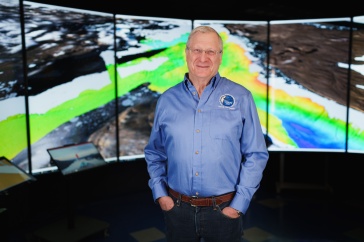
The new measuring system builds on one of the oldest and most common methods for measuring soil frost depth, the Gandahl frost tube used since the 1950s, pictured here.
“Something there is that doesn't love a wall, That sends the frozen-ground-swell under it, And spills the upper boulders in the sun; And makes gaps even two can pass abreast," Robert Frost wrote in “Mending Wall.”
The frost heaves that turn New England roads and their drivers into a bumpy, grumpy mess are one of many consequences of the seasonal soil freeze and thaw cycle that impacts about half of the northern hemisphere.
“Seasonal soil freezing is an important disturbance that can have negative consequences to our infrastructure and our ecosystems. It can destabilize roads and building, cause flooding by enhancing overland flow, and can impact the health of plants—including perennial crops—as well as forest tree species by damaging root systems,” said Alexandra Contosta, research assistant professor with the Institute for the Study of Earth, Oceans, and Space, and a researcher with the NH Agricultural Experiment Station.
Yet despite this well-known phenomenon, there is a surprising lack of soil frost research that assesses the timing and extent of frozen soil and its impacts. Contosta is the lead scientist within a team of researchers at the University of New Hampshire who received a $1.2 million grant to remedy this gap in knowledge. Scientists aim to answer two overarching questions: how does soil frost vary over space and time, and how do changing soil frost conditions affect ecosystem processes such as soil carbon and nutrient retention?
The seasonal soil freeze and thaw also plays a critical role in the control of nutrient and carbon cycles in temperate ecosystems and affects permafrost, agroecosystems, urban ecosystems, and the interface between people, buildings, and roads. A future combination of rapidly warming winters punctuated by extreme cold snaps suggests that freeze and thaw events are likely to increase in mid- to high-latitude regions, including New England. The interdisciplinary team of ecologists, hydrologists, engineers, and climate scientists working on the grant will develop and test new systems to understand the variation of soil frost across the landscape.
To do so, they will develop, test, and deploy wireless, in-ground sensors and a ground-penetrating radar system for continuous measurements of soil frost. They will use the measurements to understand how changing winter conditions affect soil frost across the landscape and will assess how ecosystems respond to the depth of soil that's frozen during the winter.
“The advent of new technologies such as low-cost microcontrollers offer an opportunity to automate the classic frost tube and increase observations in more remote sites. At the same time, the incorporation of ground penetrating radar with unmanned aerial systems enables the expansion of point-based measurements to the landscape scale. Together, these new methods will enable more frequent measurements over broader spatial areas, which will provide important insights into soil freezing and its consequences on human and natural systems,” she said.
The project is particularly significant in a changing climate. As winters continue to warm, decreases in the depth and duration of the snowpack result in an overall reduction in the insulating power of snow and render soils more vulnerable to soil frost. Yet seasonal freeze-thaw studies are often strictly limited to observed or modelled soil temperatures, which are imperfect proxies for soil frost. Currently, there are no automated sensors that directly quantify the soil frost depth or any means to detect fine resolution soil frost depth using remote sensing platforms.
“Our fully automated, wireless in-ground soil frost sensors and an unmanned aerial system ground penetrating radar technology will advance a fundamental understanding of how rapidly changing winters will impact soil microclimate. This understanding is essential to inform cold season hydrological, agricultural, and ecological processes,” Contosta said.
In addition to Contosta, the UNH scientific team includes climate scientist Elizabeth Burakowski, experiment station researcher and microbial ecologist Serita Frey, water resources engineer and surface water hydrologist Jennifer Jacobs, and electrical and computer engineer Shaad Mahmud. John Campbell, research ecologist with the US Forest Service Northern Research Station, also is a collaborator. The project will train the next generation of scientists and stakeholders in the theory and practice of understanding the local and global impacts of changing winters.
This material is based upon work supported by the NH Agricultural Experiment Station, through joint funding of the National Institute of Food and Agriculture, U.S. Department of Agriculture, under Agriculture and Food Research Initiative award number 1025737, and the state of New Hampshire.
Founded in 1887, the NH Agricultural Experiment Station at the UNH College of Life Sciences and Agriculture is UNH’s first research center and an elemental component of New Hampshire's land-grant university heritage and mission. We steward federal and state funding, including support from the USDA National Institute of Food and Agriculture, to provide unbiased and objective research concerning diverse aspects of sustainable agriculture and foods, aquaculture, forest management, and related wildlife, natural resources, and rural community topics. We maintain the Woodman and Kingman agronomy and horticultural research farms, the Macfarlane Research Greenhouses, the Fairchild Dairy Teaching and Research Center, and the Organic Dairy Research Farm. Additional properties also provide forage, forests, and woodlands in direct support to research, teaching, and outreach.
The University of New Hampshire is a flagship research university that inspires innovation and transforms lives in our state, nation, and world. More than 16,000 students from all 50 states and 71 countries engage with an award-winning faculty in top ranked programs in business, engineering, law, liberal arts, and the sciences across more than 200 programs of study. UNH’s research portfolio includes partnerships with NASA, NOAA, NSF, NIH, and USDA, receiving more than $100 million in competitive external funding every year to further explore and define the frontiers of land, sea, and space.
-
Written By:
Lori Tyler Gula, PhD | NH Agricultural Experiment Station | lori.gula@unh.edu | 603-862-1452

















































